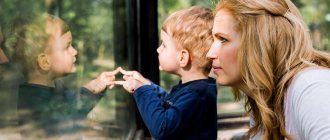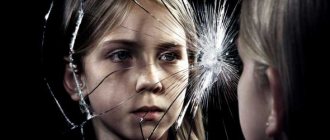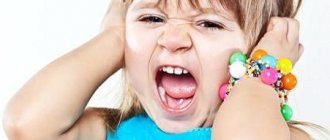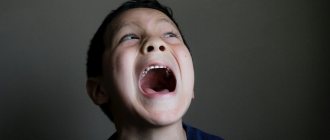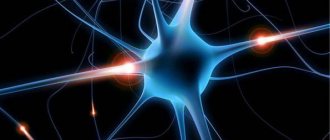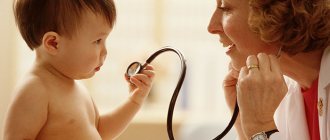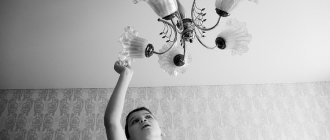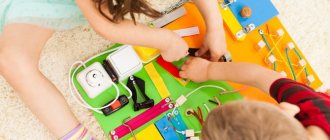Neuroses are special pathologies of the nervous system, both among adults and children, in which there is no visible damage (trauma, infections, inflammation and other influences). In this case, special deviations in the functioning of higher nervous processes are observed. These are diseases of a psychogenic nature - a person’s reaction to stress, mental trauma, and negative influences.
The process of personality formation and the active development of higher nervous activity in children begins at birth, but it most actively begins at the age of three. Very little children cannot clearly express their fears, emotions or internal state, therefore, as such, neuroses can be identified in general terms in a child after 3 years. The older the child is, the more typical and vivid the manifestations will be, especially behavioral and emotional.
Neurosis is not a mental illness, like schizophrenia or psychosis, with it there is no progressive disintegration of the personality, it is a reversible disorder of the nervous system, a disturbance in mental activity of a functional nature.
With neuroses, the nervous system experiences either a sharp and severe shock or prolonged, obsessive irritation. At the same time, disruptions begin in it, expressed in mood instability with fears, anxieties and sometimes manifestations from the organs and systems of the body (excessive sweating, appetite problems or palpitations).
Why do neuroses arise?
Both preschool children, schoolchildren, and adolescents have a particularly vulnerable nervous system due to the fact that it is not yet fully formed and immature, have little life experience in stressful situations, and cannot adequately and accurately express their emotions.
Some parents, due to busyness and other factors, often do not pay attention to the manifestations of nervous disorders in children, attributing changes in behavior to age-related characteristics or whims.
But if the child does not get help in time for neurosis, the situation may drag on, affect physical health and problems in communicating with others, developing into neurotic states in the teenager. As a result, neurosis will cause irreversible psychological changes in the personality.
The most significant factor in the increase in neuroses in children today is the increase in the number of pathologies of pregnancy and childbirth, in which hypoxia of the nervous tissues of the fetus occurs (see consequences of fetal hypoxia).
Predisposing factors for the development of neuroses are:
- predisposition to nervous system problems inherited from parents
- traumatic situations, disasters, stress
The trigger mechanism for neurosis can be:
- past illnesses
- frequent lack of sleep, physical or mental stress
- difficult family relationships
The course of the disease and its severity depends on:
- gender and age of the child
- peculiarities of upbringing
- type of constitution (asthenics, hyper- and normosthenics)
- characteristics of temperament (choleric, phlegmatic, etc.)
Clinical signs
The neurotic state of obsessive movements is indicated by:
- the need to rotate an object in your hands (pen, button)
- tapping fingers on the surface;
- lip twitching;
- snapping fingers;
- habit of biting nails.
So, babies at 2 or 3 years old will most likely suck their fingers, grind their teeth, twirl their hair, etc.
Fear neurosis in children (anxiety neurosis) in most cases is manifested by attacks of fear (severe anxiety, panic, internal tension).
The main symptoms may be:
- rapid pulse;
- sweating;
- labored breathing;
- dizziness;
- insomnia;
- chills.
Parents who have good contact with their child will be able to replace disturbances in the child’s behavior. The first symptoms of neurosis in children are a serious reason to seek help from a qualified specialist.
Hysterical state
Develops in children who are the only ones in the family or in those who are the eldest. The reason for this is the wrong attitude of parents. The child is accustomed to adults fulfilling any of his demands, as if he were the one and only. And when the situation changes, he begins to be capricious, because not everything happens as he is used to.
Psychotrauma
Psychotrauma is a change in a child’s consciousness due to any events that greatly disturb, suppress or depress him, and have an extremely negative effect. These can be either long-term situations to which the child cannot adapt without problems, or acute, severe mental trauma. Often, psychotrauma received in childhood, even if the neurosis has passed, leave their mark on adult life in the form of phobias (fear of closed spaces, heights, etc.).
- Neurosis can be formed under the influence of one unfavorable traumatic fact: fire, war, abrupt move, accident, parental divorce, etc.
- Sometimes the development of neurosis is caused simultaneously by several factors.
Children react to events differently due to their temperament and personality traits; for some, a dog barking on the street will simply be a sound irritant, but for a child predisposed to neurosis it can become a trigger for the formation of neurosis. And repeated meetings with dogs after the first shock that triggered the neurosis will gradually worsen the situation and deepen the neurosis.
The type of psychotrauma that can provoke neuroses in children depends on the age of the child.
- At 2 years old, children may develop neuroses when separated from their parents or when they begin attending children's groups.
- For older children, there may be a more serious factor - divorce of parents, physical punishment during upbringing, severe fear.
Crisis ages in the development of neuroses are the ages of three and seven years - when the age-related so-called “three-year-old and seven-year-old crisis” occurs. During these periods, the formation of one’s “I” and a reassessment of one’s attitude towards oneself occurs, and during these periods children are most vulnerable to stress factors.
No daily routine
Chaos and unpredictability are considered the main enemies of a child’s health – physical and mental. The lack of a routine is a source of stress for a fragile psyche, and this statement is more than true for teenagers. Many of the child’s nervous processes are still unstable, and the cells of the cerebral cortex are easily depleted. Late going to bed along with early getting up, lack of a daily routine cause increased fatigue, slow recovery after exercise, and therefore increased irritability and emotional instability. If activity and rest are not regulated in accordance with age (long-term activities, games, entertainment, etc.), they are accompanied by constant intense work of the brain, a large waste of nervous energy, which, even in the absence of other unfavorable factors, can lead to neurosis.
With a clear daily routine, the body independently adjusts to the upcoming activity, which is performed easily, effectively and does not cause mental stress.
Source: depositphotos.com
What most often provokes neuroses in children?
Adult Actions
One of the main provoking causes of childhood neuroses are the actions of adults, parental educational errors, which give rise to neurotic reactions, and subsequently the formation of psychological instability of the personality of an adult. Particularly negative parenting models would be:
- a model of rejection, subconscious reluctance to raise a child, in the case when, for example, they wanted a boy, but a girl was born
- model of overprotection with the development of reluctance to teach the child independence and building relationships in a team
- authoritarian model with demands for constant submission to elders, making decisions instead of the child, and not taking into account his opinion
- a model of permissiveness with the complete deprivation of the child’s control or help from parents, with the absence of any norms and order within the family and team.
- different approaches to education on the part of parents
- excessive parental rigidity
- conflicts in the family - intra-family troubles, divorces, quarrels.
They fall on the “fertile ground” of the immaturity of the children’s nervous system, and the child experiences this because in reality he cannot influence the situation and change it.
External factors
- changes in the usual way of life - moving from city to village, to an unusual area, to another country
- visiting a new children's group - starting to attend kindergarten, changing kindergarten, starting to attend school, changing schools, as well as conflicts in a kindergarten or school group
- changes within the family - the birth of a child, an adopted child, the appearance of a stepfather or stepmother, parental divorce.
Most often, neuroses are formed under the combined influence of several factors at once, and childhood neurosis is unlikely to develop in a child from a prosperous family, even after severe fear or fright. Parents in such a situation usually help to quickly cope with the problem without disturbing the nervous system.
Characteristics of the child
Children with pronounced emotionality and sensitivity - they especially need the love and attention of loved ones, the manifestation of emotions towards them. If children do not receive these emotions from loved ones, they experience fears that they are not loved and do not express emotions towards them.
Children with leadership qualities - it is also difficult with children who are independent and actively show their own opinions and leadership qualities. Such children have clearly expressed conceit in their actions or actions, and their own view of all events. They find it difficult to tolerate restrictions in their actions and parental dictatorship; it is difficult for them to be overprotected and limit their independence from an early age. Children try to protest such parental actions and become stubborn, for which they receive restrictions and punishments from their parents. This will contribute to the development of neuroses.
Weak, often sick children - children who are often sick and weakened are at risk of neuroses; they are often treated like a “crystal vase,” protecting them from everything beyond measure. Such children develop a feeling of their own helplessness and weakness.
Children from dysfunctional families - children in difficult life situations also suffer from neuroses: in asocial families, in boarding schools and orphanages.
Diagnosis of the disease
To establish the correct diagnosis, you should seek advice from a specialist (psychotherapist or psychologist).
There are often cases when you need to consult not only a neurologist and a psychologist, but also have to resort to the services of an epileptologist or neurosurgeon. The most important task is to identify the reasons that could become fundamental for the development of the disease.
List of tests that will have to be completed (not all are mandatory, depending on the symptoms):
- — MRI of the spinal cord;
- - Musculoskeletal system;
- — Doppler ultrasound of the cervical and head vessels;
- — Rheoencephalography;
- — Angitography of the head vessels;
- — Electromyography;
- — Electroencephalography;
General manifestations of neuroses
- changing children's behavior
- the emergence of new character traits
- increased sensitivity, frequent tears even for no apparent reason
- sharp reactions to minor psychological trauma in the form of despair or aggression
- anxiety, vulnerability.
Changes are also occurring at the level of children’s somatic health:
- tachycardia and blood pressure changes
- breathing problems, sweating
- digestive disorders due to stress - “bear disease”
- impaired concentration
- memory loss
- Children do not react well to loud noises and bright lights
- They sleep poorly, have restless and poor quality sleep, and are difficult to wake up in the morning.
Manifestations of various types of neuroses in children
There are quite a few types of neuroses in children; different psychological and neurological schools give different classifications. Let's consider the simplest classification of neuroses according to their clinical manifestations.
Anxiety neurosis or fear neurosis
It can manifest itself in the form of attacks of fear, which often occur when falling asleep or alone, and can sometimes be accompanied by visions. Children at different ages may have different fears:
- Among preschoolers, fears of being left alone in the house, fear of the dark, characters in scary cartoons or films, and programs are common. Often, fears are cultivated by parents themselves, frightening children for educational purposes with frightening characters - a woman, an evil witch, a policeman.
- For younger schoolchildren, this may be fears of school or bad grades, a strict teacher, or older students. Often these children skip classes due to fear.
Manifestations of this neurosis can result in a bad mood, reluctance to be alone, changes in behavior, and in difficult cases, urinary incontinence occurs. Often, such neurosis occurs in sensitive children at home who had little contact with their peers during preschool age.
Obsessive-compulsive disorder in children
It can occur in the form of neurosis of obsessive actions (obsessions) or phobic neurosis, as well as with the presence of both phobias and obsessive actions at the same time.
Obsessive actions are involuntary movements that occur during emotional stress against the child’s wishes; he can:
- blink, twinkle
- wrinkle your nose
- shudder
- tap your foot
- cough
- to sniff
A nervous tic is an involuntary twitching that occurs more often in boys, triggered by both psychological factors and the presence of certain diseases. Initially justified actions against an unfavorable background are then consolidated as obsessions:
- With eye diseases, habits of blinking, blinking, and rubbing the eyes may become established.
- With frequent colds and inflammation of the upper respiratory tract, sniffing or coughing may become more common.
They usually appear after 5 years. Such tics affect the facial muscles, neck, upper limbs, can be from the respiratory system, combined with urinary incontinence or stuttering. Such repeated actions of the same type can cause discomfort to the child, but most often they become habitual and he does not notice them. Read more about the causes and treatment of nervous tics in children.
As a rule, the tendency to neuroses begins at an early age, when stressful habitual pathological actions are formed and consolidated:
- nail biting or thumb sucking
- touching the genitals
- rocking of the body or limbs
- twirling hair around fingers or pulling it out.
If such actions are not eliminated at an early age, they contribute to neurosis due to stress in older children.
Phobic manifestations are usually expressed in the form of a special fear of:
- fear of death or illness
- confined spaces
- various objects, dirt.
Often children form special thoughts or ideas that contradict the principles of education and morality, and these thoughts create anxieties, worries, and fears in them.
Depressive neuroses
They are not typical for children; children of school age are usually prone to them, especially during puberty. The child strives to be alone, withdraws from others, and is constantly in a depressed mood with tearfulness and decreased self-esteem. Physical activity may also decrease, insomnia occurs, appetite worsens, facial expressions are inexpressive, speech is quiet and meager, and there is constant sadness on the face. This condition requires special attention, as it can lead to serious consequences.
Hysterical neuroses
Preschoolers are prone to them when there is a discrepancy between the desired and the actual. They usually fall with screams and screams on the floor or surfaces, hitting their limbs and head against hard objects. Attacks of passion may occur with imaginary suffocation or hysterical coughing, vomiting if the child is punished or does not do what he wants. In older children, analogues of hysteria may occur in the form of hysterical blindness, skin sensitivity disorders, and breathing disorders.
Neurasthenia
It is also called asthenic neurosis and occurs in schoolchildren as a result of excessive stress at school itself or an excess of additional clubs. It often occurs against a background of general weakness in children due to frequent illness or physical lack of training. Such children are disinhibited and restless, they get tired quickly, are irritable and cry often, and may have difficulty sleeping and eating.
Hypochondria
Children become concerned about their condition and health, and have unmotivated fears of developing various diseases; this often occurs among teenagers with a suspicious character. They look for symptoms and manifestations of various ailments, worrying about it, getting nervous and upset.
Neurotic logoneurosis - stuttering
Stuttering or logonerosis of a neurotic nature is more typical for boys under five years of age during the period of active development of speech and the formation of phrasal conversation. It occurs against the background of psychological trauma against the backdrop of family scandals, separation from loved ones, acute psychological trauma or fear, fright. Information overload and forced formation by parents of speech development and general development may also be reasons. The child's speech becomes intermittent with pauses, repetition of syllables and the inability to pronounce words.
Somnambulism - sleepwalking, sleep talking
Neurotic sleep disorders can occur in the form of a long and difficult time falling asleep, restless and anxious sleep with frequent waking up, the presence of nightmares and night terrors, talking in sleep and walking at night. Sleepwalking and sleep-talking are associated with the characteristics of dreams and the functioning of the nervous system. It often occurs in children from the age of 4-5 years. Children may not remember in the morning that they walked or talked at night. Read more about sleepwalking in children and adolescents.
Anorexia nervosa
Appetite disturbances in childhood are a common occurrence in both preschoolers and adolescents. Usually the reasons are overfeeding or force-feeding, the coincidence of meals with scandals and quarrels in the family, and severe stress. At the same time, the child may refuse any food or some types of it, he chews for a long time and does not swallow food, and is extremely suspicious of the contents of the plate, even to the point of gag reflex. At the same time, against the background of poor nutrition, mood changes, whims at the table, crying and hysterics are expressed.
Some variants of neuroses are:
- childhood neurotic enuresis (urinary incontinence)
- encopresis (fecal incontinence).
They arise against the background of hereditary predisposition and possibly diseases. They require a special approach in treatment, and the mechanisms are not yet fully understood.
How to make a diagnosis?
First of all, you should go to an appointment with a pediatrician or neurologist, talk with an experienced psychologist and psychotherapist. Doctors will examine and remove the organic causes of disorders and diseases that could lead to this. Neuroses are diagnosed in several stages:
- Dialogue with parents involves a detailed analysis of the psychological situation in the family, and here it is important to frankly tell the specialist all the details: the relationship in the family between parents and the child, the parents themselves, as well as the relationship between the child and peers and relatives.
- Examinations of parents and immediate relatives who are directly involved in raising a child, studying the psychological climate of the family, identifying errors in behavior and upbringing.
- Conversations with a child are a series of conversations with a child during play and communication on pre-developed questions.
- Observation of a child is a detailed observation of a child’s play activity, which occurs spontaneously or is organized in advance.
- Drawing and detailed analysis of drawings, from which one can often understand the child’s experiences and feelings, his desires and emotional state.
Based on all this, a conclusion is made about the presence and type of neurosis, then a detailed treatment plan is developed. Typically, therapy is carried out by psychotherapists or psychologists, treatment is carried out on an outpatient basis and at home, there is no need to admit a child with neurosis to the hospital.
Prevention
The main role in ensuring psychological health and preventing the development of neurosis in adolescents belongs to parents.
It is important to follow these rules:
- Strict adherence to a daily routine will help normalize the functions of an unstable nervous system.
- It is necessary to monitor the child’s loads and reduce them if symptoms of overload appear.
- Strong physical activity will help reduce psychological stress.
- In case of psychological problems in the family, you should seek the help of a psychologist.
- In stressful situations, it is necessary to provide the child with consultation with a child psychologist.
- If a teenager experiences psychological stress, it is necessary to use relaxation remedies available at home (aroma lamp with soothing essential oils on the advice of a neurologist, pine baths, breathing exercises, taking decoctions of soothing herbs, etc.).
Treatment methods for neurosis
In the treatment of neuroses in children, the main method is psychotherapy. It is important for parents to understand that on their own, with the help of books, the Internet or toys, they will achieve little, and sometimes they can do harm, aggravating the course of neurosis. Psychotherapy is a complex systemic effect on the child’s psyche and the characteristics of his character; in the treatment of neuroses it has several directions:
- group and individual therapy to study and correct the psychological climate of the family
- role-playing games with the participation of the child, helping to teach him to overcome difficult situations
- the use of art therapy (drawing) and drawing up a psychological portrait of the child based on the child’s drawings, tracking the dynamics of changes in the drawings
- hypnosis - suggestion (autogenic training)
- treatment through communication with animals - canistherapy (dogs), feline therapy (cats), hippotherapy (horses), dolphin therapy.
Psychotherapy is aimed at normalizing or significantly improving the family environment and relationships, and adjusting upbringing. , medications, reflexology and physiotherapy are also used to correct the psychosomatic background and achieve greater An individual treatment plan is developed only by a specialist for each child separately, and, if necessary, for family members.
Prevention and treatment of hysterical neurosis
Hysterics in adolescents and children are temporary and are caused by the peculiarities of mental development at this age. Therefore, specific therapy for neurosis is not carried out in this case. Children stop being hysterical when the age crisis passes.
To avoid another attack, it is recommended:
- balance your rest regime and normalize sleep;
- communicate with children, listening to their experiences;
- provide a choice of actions;
- explain the reasons for the prohibitions.
Parents with hysterical neurosis in children and adolescents need to remain calm and not punish for such behavior.
It is also important not to give in to the demands of children during hysterics, since the manifestation of weakness in one of the parents or grandparents will be a signal to the child that in this way he can get what he needs. Having realized that adults are firmly standing on their own, children, as a rule, become calmer and the number of hysterics is significantly reduced.
Application of psychotherapy
They use both group and individual or family psychotherapy. Of particular importance in the treatment of neuroses is the family form of psychotherapy. During sessions, the doctor directly identifies problems in the life of the child and his family, helps in eliminating emotional problems, normalizes the system of relationships and corrects the manner of education. Family work will be especially effective for preschool children, when its effect is maximum and it is easiest to eliminate the negative impact of basic errors in upbringing.
Family therapy
It is carried out in several successive stages:
- Stage 1 - an examination is carried out in the family and a so-called “family diagnosis” is made in the totality of personal, social and psychological characteristics, deviations in any areas of the relationship with the child.
- Stage 2 - a family discussion of problems with parents and relatives is conducted, all their problems are noted. During the conversations, the role of parents in education, the need for cooperation with a specialist is emphasized, and the perspective in the pedagogical approach is determined.
- Stage 3 - this is followed by classes with the child in a specially equipped playroom, where there are toys, writing instruments and other items. Initially, the child is given time to play independently, read or study; as emotional contact is established, a conversation will be held in a playful way.
- Stage 4 - joint psychotherapy of the child and parents. For preschoolers, joint activities are carried out with object-based games, construction or drawing; for schoolchildren, object-based games and discussions on various topics are introduced. The specialist evaluates habitual conflicts and emotional reactions in the interaction between children and parents. Then the emphasis switches to role-playing games that express children's interactions in life - family or school games. Scenarios are used that are played out by parents and children, who are swapped, and the therapist, during these games, will demonstrate the most optimal models in family relationships. This gradually creates conditions for restructuring family relationships and eliminating conflict.
Individual psychotherapy
It is carried out using numerous techniques that have a complex effect on the child. It uses the following techniques:
- Rational (explanatory)
The doctor carries out explanatory therapy through sequential steps. In a form that is accessible to the child’s age, after establishing trusting and emotional contact with him, he tells why and what is happening to the child. Then, in a playful way or in the form of a conversation at the next stage, he tries to determine the sources of the baby’s experiences. The next stage will be a kind of “homework” - this is the end of the story or fairy tale started by the doctor, where, by analyzing different options at the end of the story, attempts are made to resolve difficult situations, conflicts either by the child himself, or with the help and prompting of the doctor. Even very small successes in mastering situations, with the approval of a doctor, can contribute to further improvement of relationships and correction of pathological character traits.
- Art therapy
Art therapy in the form of drawing or sculpting can sometimes provide much more information about a child than all other methods. When drawing, a child begins to understand his fears and experiences, and observing him in the process can provide a lot of necessary information in terms of character, sociability, imagination and potential. It will be informative to draw on family topics, reflections of fears and experiences. Sometimes sculpting or paper appliqué techniques are used instead. Often, from the data in the pictures, you can get a lot of hidden information, and also, by talking about the picture, you can work through his fear with the child.
- Play therapy
It is used in children under 10-12 years of age, when they feel the need for games, but the games are organized according to a special plan and the emotional participation of the psychotherapist in them, taking into account the children’s ability to transform. Both spontaneous observation games and directed games can be used, without improvisation. In games you can practice communication skills, motor and emotional self-expression, stress relief and fear elimination. During the game, the doctor creates situations of stress, argument, fear, accusations and gives the child the opportunity to exit independently or with his help. Neuroses are treated especially well with this method at the age of up to 7 years.
A variant of play therapy is fairy tale therapy, in which fairy tales are invented and told with the production of special characters, puppets or dolls. Special therapeutic tales can be listened to in the form of meditation, accompanied by calm music in a supine position. There may also be psycho-dynamic meditations-fairy tales with the child transforming into animals and performing exercises.
- Autogenic training
Treatment with autogenic training is carried out in adolescents - this is a method of muscle relaxation, especially effective for systemic neuroses with stuttering, tics, and urinary incontinence. Creating a positive mood through the speech and actions of the doctor (for example, imagining yourself in the most pleasant place) leads to muscle relaxation, a decrease or even complete disappearance of manifestations. As the sessions progress, this state is consolidated in the subconscious, and the belief that it is quite possible to recover increases.
- Suggestive (suggestion method) psychotherapy
This is a suggestion to a child while he is awake, under hypnosis or indirect suggestion of certain attitudes. Often, children are good at indirect suggestion - for example, taking a placebo will give them recovery. At the same time, they will think that they are taking a particularly effective drug. The method is especially good for hypochondria, in school and adolescence.
- Hypnosis
Hypnotherapy is used only in particularly difficult cases in order to mobilize the psychological and physiological resources of the body. It quickly eliminates certain symptoms. But the method has many contraindications and is used to a limited extent in children.
Group psychotherapy
Indicated in special cases of neuroses, these include:
- long-term course of neurosis with unfavorable personality changes - increased level of demands on oneself, self-centeredness
- difficulties in communication and related disorders - embarrassment, timidity, shyness, suspiciousness
- in case of difficult family conflicts, the need to resolve them.
Groups are formed according to individual therapy by age; there are few children in the group:
- under 5 years of age - no more than 4 people
- aged 6 to 10 years - no more than 6 people
- at the age of 11-14 years - up to 8 people.
Classes last up to 45 minutes for preschoolers and up to one and a half hours for schoolchildren. This allows you to play out complex stories and involve all group members in them. Children united in groups visit exhibitions and museums, read interesting books, discuss all this, and share their hobbies. In this way, the child’s tension is relieved, the children open up and begin to communicate, sharing their pain and experiences.
Compared to individual training, the effect of group training is greater. Spontaneous and specialist-guided games are gradually introduced, training of mental functions begins, and adolescents are taught self-control. As homework, various tests with pictures are used, which are subsequently discussed in the group.
The classes involve relaxation and inculcation of positive personality traits acquired during the class. At the end of the course, there is a general discussion and consolidation of the results, which helps the child to work independently on himself in the future.
Drug therapy
Drug therapy is of secondary importance in the treatment process. As a rule, it is carried out before psychotherapy. Appointed:
- general strengthening, tonic preparations (vitamins B, C, calcium preparations);
- nootropics (piracetam);
- drugs to reduce the amount of fluid in the body or individual organs (diuretics);
- tinctures of medicinal herbs (herbs that have a calming effect);
- tranquilizers - used only in case of excessive activity, disinhibition (chlordiazepoxide);
- physiotherapy (electrophoresis, electrosleep);
- It is possible to use small doses of antidepressants (imiprapine).
It should be remembered that only a doctor can prescribe the medications necessary to treat the disease.
